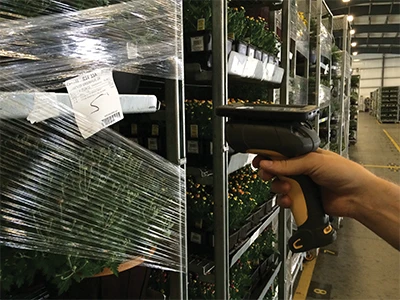
 Technology has allowed growers to improve efficiencies which ultimately increases profits. Yet, like using the correct tools to grow a healthy plant, it takes the correct tech tools to grow healthy profits. Here are three examples of the use of technology for production, inventory and shipping.
Technology has allowed growers to improve efficiencies which ultimately increases profits. Yet, like using the correct tools to grow a healthy plant, it takes the correct tech tools to grow healthy profits. Here are three examples of the use of technology for production, inventory and shipping.
Growing ahead of the curve: North Creek Nurseries
With the eventual goal of getting all of his employees out of the office and into the nursery, Gordon Rowe, special operations manager at North Creek Nurseries Inc. in Landenberg, Penn., is moving in tandem with changing technology and perhaps is even a little ahead of the curve for greenhouse growers.
Right now North Creek utilizes custom apps designed for nursery growers to collect relevant data for the more than 7 million plants and thousands of orders placed annually.
“We can take a tablet into the greenhouse and have order information as long as we have a WiFi connection,” says Rowe. “We can build orders right out in the field.”
The apps save a lot of time for the growers who historically relied on clipboards and handwritten notes. For instance, Rowe says not long ago, a worker would have to go house by house, flagging individual flats that needed to be trimmed and later reconcile that with the paper orders back in the office. Today, all this is done with apps, freeing up time for other duties, like growing a good crop of liners.
These apps are a time saver in themselves, but it’s only the tip of the iceberg for North Creek when it comes to improving efficiencies. It’s what Rowe and the entire North Creek staff can do with the data that is more significant, which goes beyond simply keeping track of inventory and production scheduling.
Rowe uses what he calls a souped-up version of pivot tables to extrapolate data collected in real time to provide meaningful metrics that saves time and money.
“I’ve been doing a lot of work with Microsoft Power BI Suite,” says Rowe, who admits to being a self-taught person. “I can build interactive tables for folks to use—Power BI is a game changer, bar none.”
 Production planning is where Rowe has really been able to shave off time spent in the office instead of in the houses. In the past, he says they would lay out all the orders on a table. It would take four people, working 40 hours for four weeks to put the production plan in place. Now, it takes the same number of people working just one day per week for four weeks to do it with the software they’re using.
Production planning is where Rowe has really been able to shave off time spent in the office instead of in the houses. In the past, he says they would lay out all the orders on a table. It would take four people, working 40 hours for four weeks to put the production plan in place. Now, it takes the same number of people working just one day per week for four weeks to do it with the software they’re using.
“Now I have everything in one view,” says Rowe, referring to the spreadsheet he created with Power BI. “We’ve shaved our production planning process time by 70 percent easily.”
Rowe says he wants to move the creation of reports and using technology “from nouns to verbs,” meaning that the software must do what they want it to do and not be limited by what software dictates.
Of course, it all comes down to growing good plants. The software should free up more time to do just that, which of course means more production and less crop loss.
“You can’t run a nursery from behind a desk," says Rowe. "You have to be out in the trenches to see what is happening."
Ship and replenish: WindMill Farms Nurseries
WindMill Farms Nurseries, located in central Florida, is a producer of finished containers for southern markets. They use a box store replenishment system to ensure the shelves of big box stores are kept bursting with color from their beautiful plants during peak buying periods.
Rob Lower, vice president of sales at WindMill Farms, oversees the time-saving software that helps the company achieve its sales goals.
“It would be impossible to replenish the product the old way, a nightmare,” says Lower. “It was easier when you had just a few products to do it manually.”
With the box store replenishment system they have in place they can see at a glance not only what is selling at each of the 150 stores they service, they can also see the price that has been set by the retailer. If a price has been lowered at one of the stores, but not another, they can quickly find out why.
Growers and retailers have been able to hone in on exactly what is selling and what is not, made possible by increasingly sophisticated technology. In fact, the process itself has demanded businesses like WindMill Farms to continually work to improve their software applications.
“Up until a few years ago the box stores used the same SKU for several different varieties,” says Lower. “Now every perennial item has its own item specific SKU for more accurate sales data.”
Staying on point at Color Point
Correct scanning of plant carts can make the difference between getting paid for your hard work or working for naught. At Color Point, which is headquartered in Paris, Ken., Stephen VanWingerden worrks tirelessly to perfect a cart scanning validation system to accurately ship plants to the big box stores.
 Having an accurate scanning system in place is even more important these days than it was just a few years ago. VanWingerden says everything used to come down to the size, at retail. However, two years ago they had what is referred to as “item breakout” where they broke each size down to the genus.
Having an accurate scanning system in place is even more important these days than it was just a few years ago. VanWingerden says everything used to come down to the size, at retail. However, two years ago they had what is referred to as “item breakout” where they broke each size down to the genus.
“For some size we went from one SKU to 14 or more,” says VanWinderden. Substitutions are also more frequent than before, which is why it was imperative they implement a cart-scanning system.
“You may have run replenishment for a petunia out on the cart, but when there has been a substitution, you can’t handle those manually,” says VanWingerden. The solution is to scan to validate what's on the cart before it's shipped. Scanning the carts, he says, will override the original order, while validating that accurate product has been pulled or substituted, and make the cart ready to be received by the retailer.
Like Rowe, VanWingerden is continually trying to stay ahead of the curve with technology, with the goal of making sure every thing that is being shipped matches the original order. For Color Point, that also means preparing for Good Faith Receiving, which requires orders are accurate down to the plant or they won’t get paid for it.
“It’s very important we pull accurately,” says VanWingerden. “If we make too many inaccurate substitutions it becomes shrinkage at the stores, and there's a snowball effect."
VanWingerden and other employees at Color Point use customized apps from SBI Software, tailored to how they want to scan carts. Right now, the carts are scanned before shipping. However, they want to be able to scan the carts after they pull them in the greenhouse, before they leave the shipping barn and be able to have data in “real time." This allows them to see their progress throughout the day and what carts remain to be pulled.
“We don’t think we’ve reached perfection, there is still room for improvement. I definitely think we’re improving a lot from season to season
Neil Moran is a horticulturist and freelance writer based in Sault Ste. Marie, Mich.

Explore the March 2015 Issue
Check out more from this issue and find your next story to read.
Latest from Greenhouse Management
- Terra Nova Nurseries introduces rust-free and disease-resistant heucherella
- John T. Nickel, founder of Greenleaf Nursery Co., passes away at 89
- Three tours offered at 2025 Farwest Show
- Garden Media Group announces sixth annual Women in Horticulture Week
- Star Roses and Plants announces National Knock Out Rose Day
- The Growth Industry Episode 4: How federal budget cuts are affecting horticulture nonprofits
- The thrips battle plan
- Pennsylvania Horticultural Society shares top gardening trends from 2025 Philadelphia Flower Show





